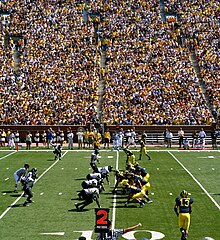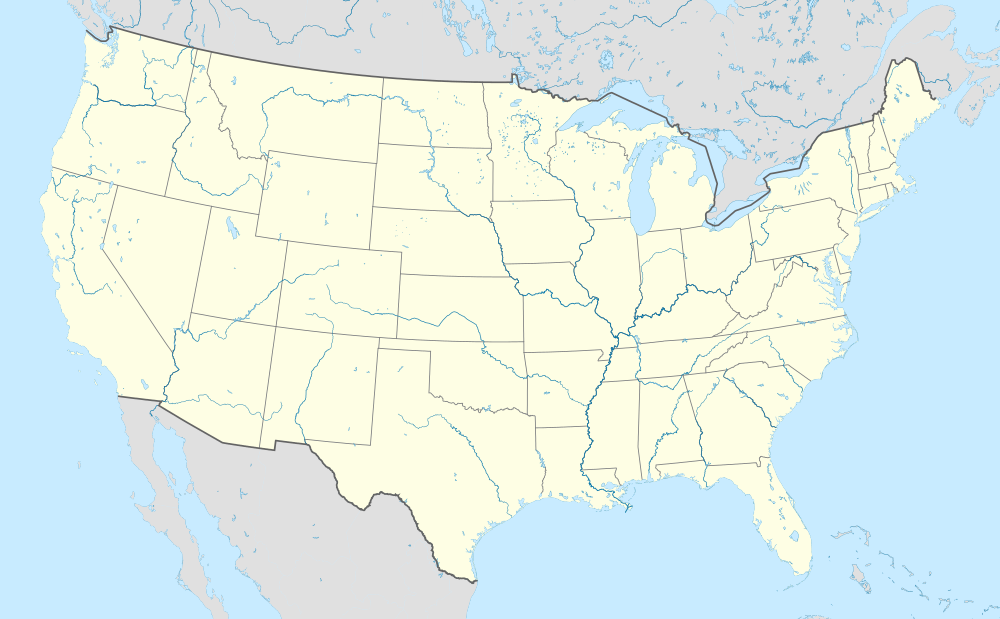Group of Five conferences

In college football, the term Group of Five is an informal term which refers to five athletic conferences whose members are part of NCAA Division I Football Bowl Subdivision (FBS). The five conferences are the American Athletic Conference (American), Conference USA (C-USA), Mid-American Conference (MAC), Mountain West Conference (MW), and Sun Belt Conference (SBC or Sun Belt).[1][2][3][4][5]
Division I football conferences
The Group of Five conferences are five of the ten conferences in NCAA Division I FBS. The other five FBS conferences are informally known as the Power Five.[1][2][3][5] In addition, a number of schools compete in FBS as independents in football.
The terms Group of Five and Power Five are not formally defined by the National Collegiate Athletic Association (NCAA), and the precise origins of the terms are unknown. However, each of the ten conferences are named in the NCAA's Division I manual.[6][7][8] A notable difference between the Group of Five and Power Five are designated areas of institutional autonomy granted to member institutions of the Power Five conferences.[9][10][11]
The Group of Five is often considered disadvantaged as to the Power Five, as its constituent members do not have similar access to New Year's Six or College Football Playoff bowls. Since the BCS era, this has been an ongoing area of contention among NCAA Division I schools.[3] In November 2012, agreement was reached to guarantee a spot in one of the New Year's Six bowl games to a team from one of the Group of Five conferences, beginning with the 2014 football season.[5]
On December 5, 2021, Cincinnati became the first Group of Five team to make the College Football Playoff.[12]
In sports other than football (mainly basketball), conferences outside of the Power Five are known as mid-major conferences.
Current conferences and teams
The ten current FBS conferences are listed below. For the Group of Five, the football members of each conference are also listed.[a] Independent NCAA Division I FBS teams are listed in a third table. Tables reflect conference memberships as of the 2022 football season.
- ^ As of the 2022 season, one Group of Five conference has a full member that does not have a football team, namely Wichita State in The American.
- ^ a b c d BYU, Cincinnati, Houston, and UCF have announced they will join the Big 12 Conference in 2023.
- ^ a b c d e f Charlotte, Florida Atlantic, North Texas, Rice, UAB, and UTSA have announced they will join the American Athletic Conference in 2023.
- ^ Notre Dame normally competes as an independent in football; for the 2020 season, it competed as an ACC member.
- ^ a b Liberty and New Mexico State have announced they will join Conference USA in 2023. Current FCS members Jacksonville State and Sam Houston will also join C-USA at that time. FCS member Kennesaw State will join CUSA in 2024
Map of Group of Five teams
2022 Map of Group of Five Teams
|
|---|
|
This map shows Group of Five teams during the 2022 season. Colors indicate conference membership: American (blue), C-USA (green), MAC (pink), Mountain West (orange), Sun Belt (red), and Group of Five independent (grey). Not shown is Hawaii, a football-only member of the Mountain West.
|
References
- ^ a b McMurphy, Brett (August 7, 2014). "Power Five coaches polled on games". ESPN. Retrieved December 30, 2019.
- ^ a b McMurphy, Brett (December 29, 2016). "Group of 5 officials considering playoff for non-Power 5 teams". ESPN. Retrieved December 30, 2019.
- ^ a b c Solomon, Joe (January 2, 2017). "SEC commissioner explains why Group of Five should 'be careful' about playoff idea". CBS Sports. Retrieved December 30, 2019.
- ^ Walder, Seth; Sabin, Paul (October 4, 2019). "Which teams would reach a Group of 5 College Football Playoff?". ESPN. Retrieved December 30, 2019.
- ^ a b c Mandel, Stewart (November 12, 2012). "Big East, rest of 'Group of Five' score victory with six-bowl decision". SI.com. Retrieved December 30, 2019.
- ^ "4.2.1(a) Division I Board of Directors" (PDF). 2019–20 NCAA Division I Manual. July 2019. p. 21. Retrieved December 30, 2019.
- ^ "4.2.1(a) Division I Board of Directors" (PDF). 2018–19 NCAA Division I Manual. July 2018. p. 21. Retrieved December 30, 2019.
- ^ "4.2.1(a) Division I Board of Directors" (PDF). 2017–18 NCAA Division I Manual. July 2017. p. 21. Retrieved December 30, 2019.
- ^ "5.3.2.1 Process for Areas of Autonomy" (PDF). 2019–20 NCAA Division I Manual. July 2019. p. 33. Retrieved December 30, 2019.
- ^ "5.3.2.1 Process for Areas of Autonomy" (PDF). 2018–19 NCAA Division I Manual. July 2018. p. 33. Retrieved December 30, 2019.
- ^ "5.3.2.1 Process for Areas of Autonomy" (PDF). 2017–18 NCAA Division I Manual. July 2017. p. 33. Retrieved December 30, 2019.
- ^ "Bama, Michigan, UGA, Cincy to vie for CFP crown". ESPN.com. 2021-12-05. Retrieved 2021-12-05.

